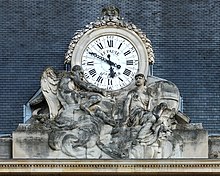Jean André Lepaute

Jean André Lepaute (born November 23, 1720 in Thonne-la-Long , † April 11, 1789 in Saint-Cloud ) was a French royal watchmaker .
Life
Jean André Lepaute was born as one of nine children of toolmaker , locksmith and guild master André Lepaute and his wife Elisabeth Doulet.
1740 at the age of twenty years ago Jean André went to Paris to a watchmaker in the teaching . He later founded his own company there. His good reputation as a watchmaker helped him to win many orders for the construction of large public clocks . In 1747 his younger brother Jean Baptiste Lepaute came to Paris to work in the company.
During this time he got an order to build a large clock for the Palais du Luxembourg . When the clock was delivered, he met the astronomer Nicole-Reine Étable de la Brière . The two fell in love and on August 27, 1748 made a marriage. Since then, Jean André has lived in the Palais du Luxembourg. The young couple often received friends from aristocratic circles. Together with his wife Nicole he worked on calculations for his astronomical clocks , calendar clocks and planetary machines .
In 1751 he began as a royal watchmaker for Louis XV. to work.
In 1754, the then young Pierre Augustin Caron de Beaumarchais , Jean André Lepaute showed a new escapement he had invented , the so-called double point escapement . Lepaute immediately recognized the importance of this invention and published it under his own name at the French Academy of Sciences in 1754 . When Pierre Augustin Caron noticed it, he immediately wrote to the academy. With the help of an article in the Paris newspaper Mercure de France , which reported on Beaumarchais double-point escapement before Lepautes was published, he was able to clearly demonstrate that Beaumarchais was the originator of the new escapement. The academy followed his argument and granted him the patent .
In 1774 Jean André Lepaute withdrew from the business, which he left to his nephews Pierre-Basile Lepaute and Pierre Henry Lepaute . He died a year after his wife at the age of 68 in Saint Claude near Paris. Jean André Lepaute was the founder of the Lepaute watchmaking dynasty.
Services

In 1750 he presented his comma inhibition to the public . At almost the same time, Jean-Antoine Lépine also used an escapement of a similar construction for his watches .
In 1751 Lepaute manufactured some pendulum clocks with only one wheel.
In 1753 he improved the scissor escapement and introduced it to wall and stick clocks in general.
Around 1770 he made an atmospheric clock for the Academy of Sculpture that was automatically wound by the draft . The Lepaute company was also known for the manufacture of clocks with digital displays.
Fonts
Traité d'Horlogerie, contenant tout ce qui est nécessaire pour bien connoître et pour régler les pendules et les montres, la description des Pièces d'Horlogerie les plus utiles, des répétitions, des équations, des Pendules à une roue, & c. celle du nouvel échpement, un Traité des engrénages. Augmenté de la description d'une nouvelle pendule policamératique. ; Paris 1755.
Web links
- Jean-André Lepaute in Biographies (French)
- Lepaute, Jean André in UhrenLexikon
- Lepaute, Jean André in Watch-Wiki
- Clocks by Jean André Lepaute in the Metropolitan Museum of Art
- Watches by Jean André Lepaute in the Wallace Collection
- Restoration of the Clio and Urania mantel-clock by Jean-André Le Paute in the Hermitage (Saint Petersburg) (English)
Individual evidence
- ↑ Jean André Lepaute in Geneanet.org
- ↑ Fritz von Osterhausen: Callweys lexicon . Munich 1999, ISBN 3-7667-1353-1 ; P. 187
- ^ Dictionnaire des Horlogers Francais ; Tardy; Paris 1975; P. 378f
- ↑ Traité d'horlogerie ... in Biblioteca Digitale
| personal data | |
|---|---|
| SURNAME | Lepaute, Jean André |
| BRIEF DESCRIPTION | French royal watchmaker |
| DATE OF BIRTH | November 23, 1720 |
| PLACE OF BIRTH | Thonne-la-Long |
| DATE OF DEATH | April 11, 1789 |
| Place of death | Saint-Cloud |

